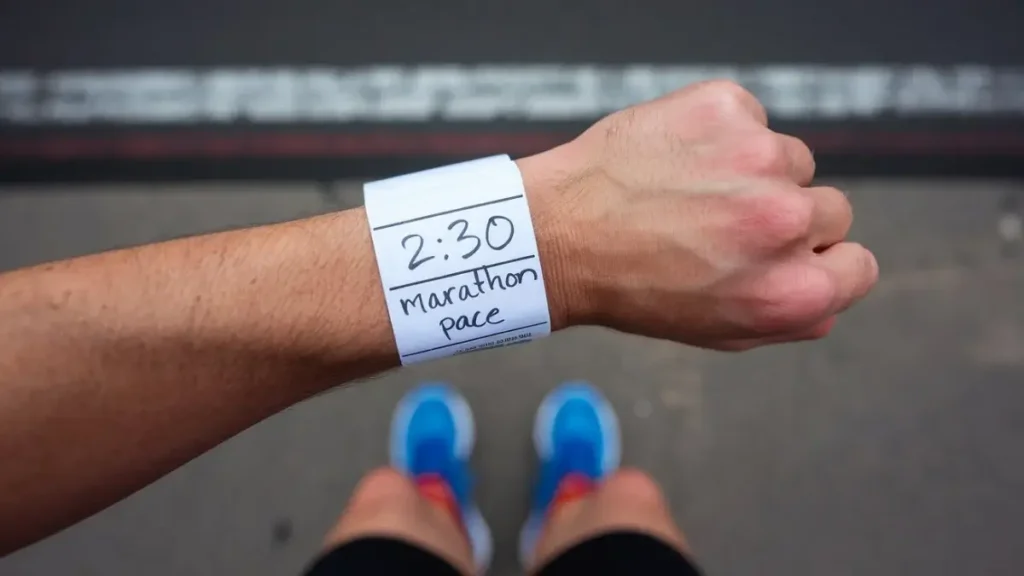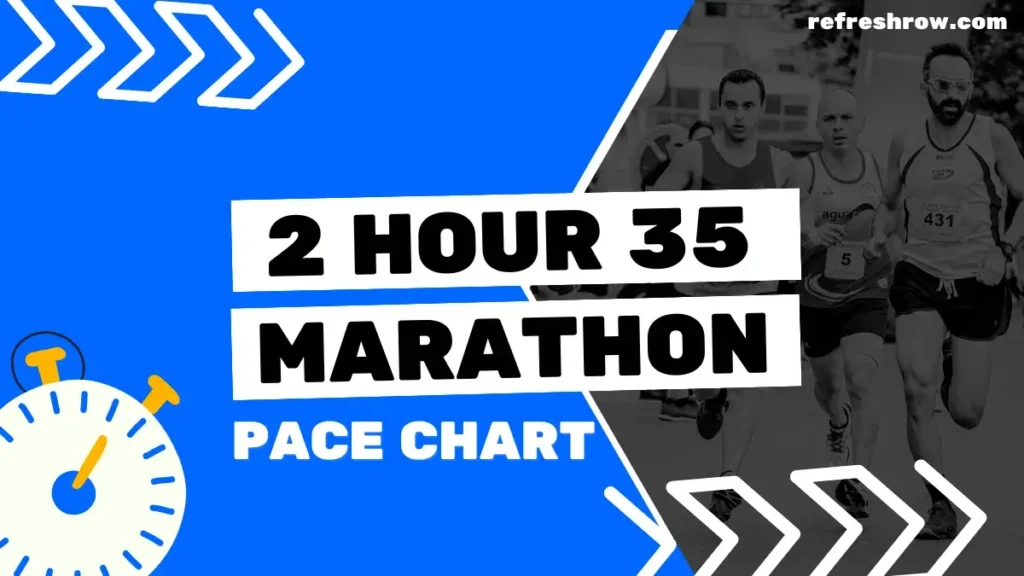To run a 4:30 hour marathon you need to run at a pace of 10:18 per mile or 6:24 per kilometer.
Following the splits below (and shaving off a second), you’ll run a sub 4:30 marathon.
I’d recommend aiming to run 1-2 minutes ahead of the split target time from 10 miles, as you’ll likely come up against crowding on race day.
4:30 Marathon Pace in Miles
| Mile | Split |
|---|---|
| 1 | 10:18 |
| 2 | 20:36 |
| 3 | 30:54 |
| 4 | 41:12 |
| 5 | 51:29 |
| 6 | 1:01:47 |
| 7 | 1:12:05 |
| 8 | 1:22:23 |
| 9 | 1:32:41 |
| 10 | 1:42:59 |
| 11 | 1:53:17 |
| 12 | 2:03:35 |
| 13 | 2:13:52 |
| 14 | 2:24:10 |
| 15 | 2:34:28 |
| 16 | 2:44:46 |
| 17 | 2:55:04 |
| 18 | 3:05:22 |
| 19 | 3:15:40 |
| 20 | 3:25:58 |
| 21 | 3:36:15 |
| 22 | 3:46:33 |
| 23 | 3:56:51 |
| 24 | 4:07:09 |
| 25 | 4:17:27 |
| 26 | 4:27:45 |
| 26.2 | 4:30:00 |
Download
4:30 Marathon Pace in KM
| KM | Split |
|---|---|
| 1 | 6:24 |
| 2 | 12:48 |
| 3 | 19:12 |
| 4 | 25:36 |
| 5 | 32:00 |
| 6 | 38:24 |
| 7 | 44:48 |
| 8 | 51:11 |
| 9 | 57:35 |
| 10 | 1:03:59 |
| 11 | 1:10:23 |
| 12 | 1:16:47 |
| 13 | 1:23:11 |
| 14 | 1:29:35 |
| 15 | 1:35:59 |
| 16 | 1:42:23 |
| 17 | 1:48:47 |
| 18 | 1:55:11 |
| 19 | 2:01:35 |
| 20 | 2:07:59 |
| 21 | 2:14:23 |
| 22 | 2:20:46 |
| 23 | 2:27:10 |
| 24 | 2:33:34 |
| 25 | 2:39:58 |
| 26 | 2:46:22 |
| 27 | 2:52:46 |
| 28 | 2:59:10 |
| 29 | 3:05:34 |
| 30 | 3:11:58 |
| 31 | 3:18:22 |
| 32 | 3:24:46 |
| 33 | 3:31:10 |
| 34 | 3:37:34 |
| 35 | 3:43:58 |
| 36 | 3:50:22 |
| 37 | 3:56:45 |
| 38 | 4:03:09 |
| 39 | 4:09:33 |
| 40 | 4:15:57 |
| 41 | 4:22:21 |
| 42 | 4:28:45 |
| 42.2 | 4:30:00 |
Download
Other Marathon Pace Charts
Targeting a different time?
Check out the Full Marathon Pace Chart in Miles or KM
Or select a specific finishing time below:
| 3:00 | 4:00 | 5:00 | |
| 3:05 | 4:05 | 5:15 | |
| 3:10 | 4:10 | 5:30 | |
| 3:15 | 4:15 | 5:45 | |
| 3:20 | 4:20 | 6:00 | |
| 3:25 | 4:25 | 6:15 | |
| 2:30 | 3:30 | 4:30 | 6:30 |
| 2:35 | 3:35 | 4:35 | 6:45 |
| 2:40 | 3:40 | 4:40 | 7:00 |
| 2:45 | 3:45 | 4:45 | |
| 2:50 | 3:50 | 4:50 | |
| 2:55 | 3:55 | 4:55 |
Training for a 4:30 Marathon
Is 4:30 a Good Marathon Time?
Well, what do the stats say?
Run Repeat conducted a study that contains 19,614,975 marathon results from more than 32,335 races across the globe, here is how a 4:30 marathon compares against age and gender for the races recorded:
| Overall | You’re faster than 46.9% of all runners. |
| Male | You’re faster than 36.2% of males. |
| Female | You’re faster than 61.2% of females. |
| <20 | You’re faster than 45.4% of under 20s. |
| 20-29 | You’re faster than 39.7% of 20-29 year olds. |
| 30-39 | You’re faster than 39.4% of 30-39 year olds. |
| 40-49 | You’re faster than 43.8% of 40-49 year olds. |
| 50-59 | You’re faster than 56.8% of 50-59 year olds. |
| >60 | You’re faster than 76.5% of over 60s. |
Training Runs and Paces for a 4:30 Marathon
To break a 4:30 marathon you’ll need to do some serious distance in your training, I recommend at least 15 miles (24km) per week.
You’re also going to need to make sure you’ve crossed off these milestones for other race distances:
- A 5k in 27:50 mins
- A 10k in 58:50 mins
- A half marathon in 2 hours 4 mins
Training Paces
| Pace | Mins per Mile | Mins per KM |
|---|---|---|
| Easy | 11:36 | 7:12 |
| Steady | 10:18 | 6:23 |
| 10k | 9:26 | 5:52 |
| 5k | 9:03 | 5:37 |
| 1 Mile | 8:24 | 5:15 |
Weekly Mileage Targets
| Target Mileage: | Gradually increase your weekly mileage from 20 miles (32 km) to a peak of 30 miles (48 km). |
| Incremental Increase: | Increase mileage by approximately 10% each week, with every fourth week as a recovery week where mileage is reduced by 20-30%. Make sure to taper for the last 1-2 weeks. |
Long Run Structure
| Total Distance: | Build up to long runs of 18-20 miles (29-32 km). |
| Segment Example: | First 5 miles (8 km): Easy pace, heart rate 140-150 bpm (approximately 12:30/mile or 7:45/km). Next 1 mile (1.6 km): Fast pace at 8:50/mile (5:30/km). Next 5 miles (8 km): Medium effort, heart rate around 160 bpm (approximately 9:50/mile or 6:06/km). Repeat: Repeat the segment twice (5 miles easy, 1 mile fast, 5 miles medium), you can taper the final 2 miles if required. |
Why This Works: Incorporating varied paces within long runs enhances lactate tolerance, which helps on race day when you’ve got to maintain pace despite feeling fatigued. By practicing surges during a run, you can build up your physical and mental resilience (lots of elite marathon runners use these strategies during their training)
Alternating Long Runs: Alternate between structured long runs (easy/fast segments) and easier long runs. For easier long runs, maintain a steady, comfortable pace throughout, focusing on mileage rather than speed to aid recovery.
Speedwork Sessions
| Short Intervals: | – 800m repeats at 4:20 per interval (5:20/km). – Aim for 6-8 repetitions with equal time for recovery. |
| Mile Repeats: | – 1 mile repeats at 8:50 per mile (5:30/km). – Aim for 4-6 repetitions with a 1-2 minute recovery jog. |
| Longer Intervals: | – 2 mile repeats at 9:00 per mile (5:35/km). – Aim for 3-5 repetitions with a 2-3 minute recovery jog. |
Recovery and Rest Days
| Rest Days: | Incorporate 1-2 rest days per week to allow your body to recover and prevent overtraining. |
| Easy Run Days: | Include 1-2 easy run days per week at a relaxed pace of 12:45/mile (7:55/km), covering 3-5 miles (5-8 km) per day. Try to keep your heart rate below 140 bpm on easy days to ensure proper recovery and aerobic development. |
My Tips to Run a Sub 4:30 Marathon
Break Down Your Long Runs
One strategy that worked wonders for me during my training was chopping up my long runs into manageable segments.
Instead of thinking of a 15-mile run as one long, daunting challenge, I’d mentally divide it into smaller 5-mile chunks.
Then, every 5 miles, I’d give myself a mini-reward, like a favorite candy or a mental high-five.
(or sometimes a physical one, with some very awkward stares from dog walkers).
This approach made the miles feel less overwhelming and helped me stay motivated, especially during those tougher long runs.
Give this technique a go during your training – it can make a huge difference in keeping a positive mindset.
Train on Rolling Hills to Build Endurance
Everyone hates hills – me included.
But by training on them, you’re hopefully flatter marathon is going to feel so much easier.
Or if that’s not for you, give “rolling hills” a go.
They have subtle inclines that mimic the undulating terrain you might encounter on race day and help build both your strength and endurance.
You don’t need to seek out massive hills – just choose routes with gentle, consistent elevation changes.
Training on rolling hills also improves your mental toughness, as it teaches you to maintain a steady effort whether you’re going uphill or down.
When race day comes, you’ll be ready to boss it up the hills, leaving the unprepared in your wake.
Find Your Ideal Pace with Negative Splits
Aiming for any marathon time all comes down to pacing yourself wisely.
One technique you can try (which is used by lots of pros) is running negative splits, where you start at a slightly slower pace and gradually increase your speed in the second half of the race.
This method allows you to conserve energy early on and finish strong.
During your training runs, practice this by starting at a comfortable pace and then picking it up very slightly every mile/km.
Knowing that you can accelerate when it counts, rather than slowing down as you tire is such a confidence booster.
Make Strength Training a Priority
Running isn’t just about your legs, your entire body needs to be strong to handle the demands of a marathon.
I’d recommend incorporating strength training into your routine at least once to twice a week.
Focus on exercises that target your core, glutes, and legs, like squats, lunges, and planks.
Stronger muscles not only improve your running form but also help prevent injuries.
This all might seem like extra work, but even 20-30 minutes of strength training can make a significant difference in how you feel during those later miles of the marathon.
It also forces you to do some extra stretching throughout the week, making sure you’re limber for your runs.


Row Brown is the founder of Refresh Row. He is a keen marathon runner, his favorite being the London Marathon. He’s now set himself the mission of Running the Entire Length of Spain, which is scheduled for late 2024.


